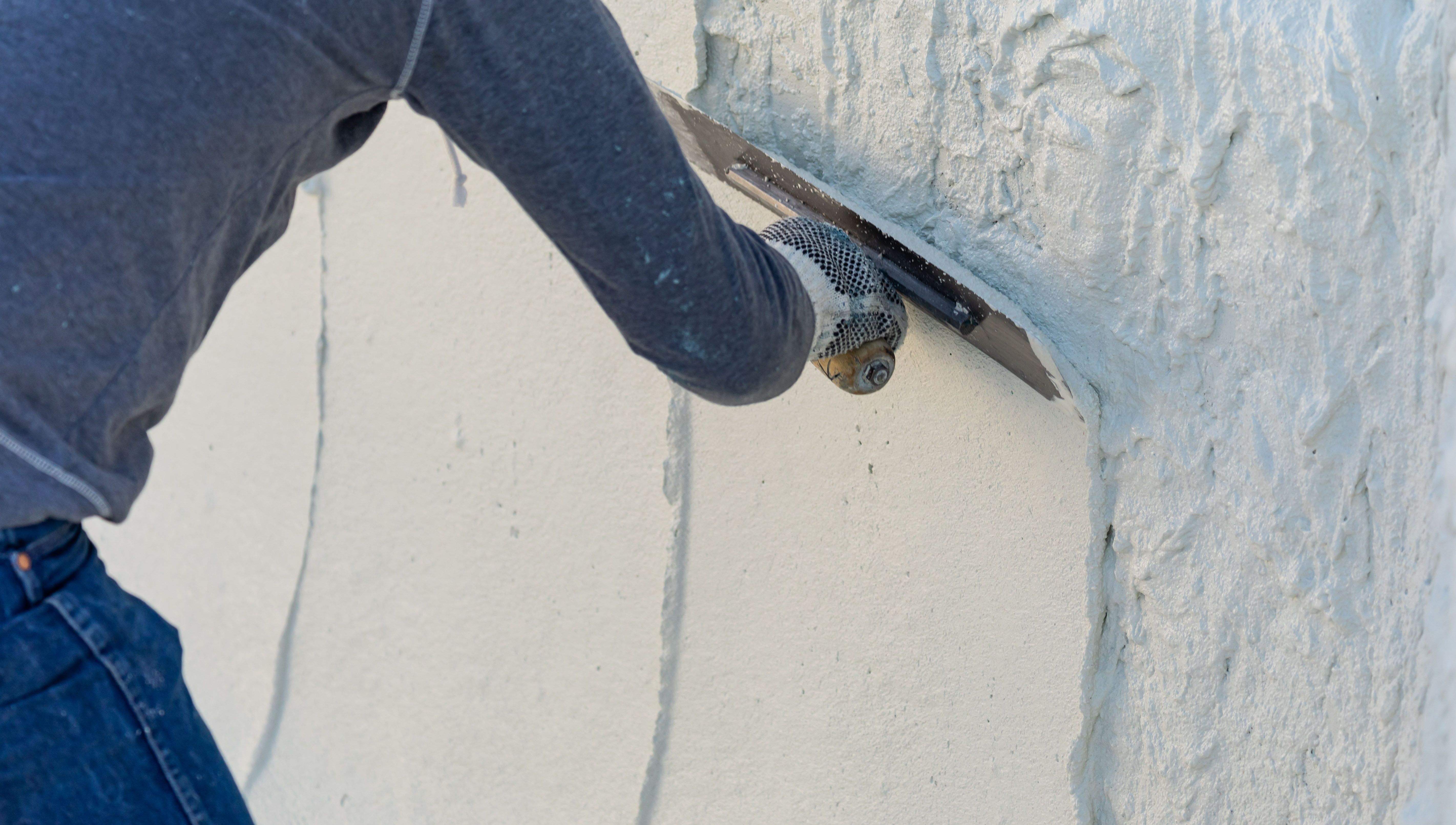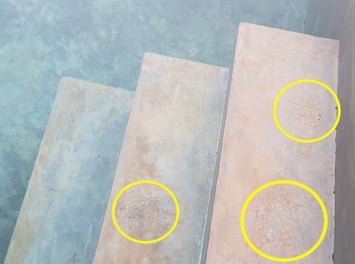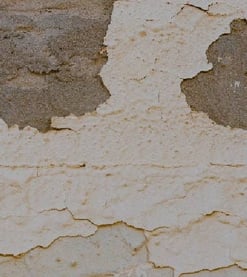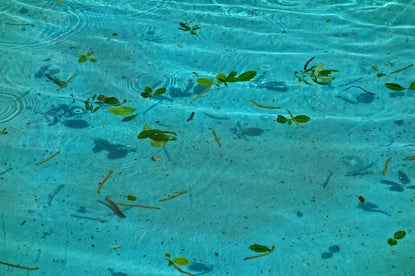Pool Plaster Repair 101: Common Pool Plaster Problems and How to Fix Them
January 29th, 2020
4 min read

Are you getting an inground concrete pool, or do you already have one? If you’re on a budget, chances are you’re going to choose plaster for your pool surface, and it’s not a bad choice.
Pool plaster is the cheapest option, and it’s the classic choice for concrete inground pools. On the flip side, it’s also the least durable, rough to the touch, and comes with its share of problems.
Since we at River Pools have been in the swimming pool industry for many years specializing in fiberglass, we’re going to share some of the issues that you may encounter and the different types of pool plaster repair jobs that you need to know about.
Let's dive in...
Pool Plaster Crazing
Craze cracks are small clustered cracks that occur when the pool plaster shrinks. Plaster tends to shrink as water in the plaster mix gets absorbed during the curing process, but if there is too much shrinking, craze cracks can appear.
Pool plaster crazing is a pretty common problem, and the consequences are usually minor. When the crazing is too bad, however, it can cause staining, algae issues, and calcium nodules. A bad case of crazing will require you to replaster your swimming pool.
 Exhibit A: Craze cracks appearing on pool steps
Exhibit A: Craze cracks appearing on pool steps
Pool Plaster Etching and Scaling
You might have a problem with etching if your pool surface becomes excessively rough. Etching happens when lines and dents are literally carved into your pool plaster over time. This is caused by improperly balanced pool chemistry, particularly low pH, alkalinity, or calcium, and it's one of the reasons why we emphasize the importance of taking care of your pool correctly.
Scaling is another problem and can occur as a result of high pH, alkalinity, or calcium. This can lead to a buildup of calcium and other minerals in your pool. Not pretty.
Here’s how to avoid scaling in your pool:
- Brush the pool walls regularly
- Pre-dilute acid before you add it to the water
- Don’t add salt within 30 days of replastering your pool
- Never allow salt to sit on fresh plaster
The most important takeaway: make sure your pool is clean and your water chemistry is balanced. Regular and consistent maintenance goes a long way and can preserve your plaster longer.
Pool Plaster Spalling
Your plaster might become a victim of spalling if your pool is troweled incorrectly. For example, if your plaster is over troweled or if the troweling is improperly timed, a thin layer of plaster (about one-eighth of an inch) can begin to flake and peel off, which can set your project back another month. This can also occur as a result of adding too much water while troweling.
So, how can you fix it? You can often fix plaster spalling by sanding the area down to reveal a much smoother underlayer. If spalling has taken over a large area of your pool, it might be better to start fresh and have your entire pool replastered.
 Exhibit B: Spalling plaster
Exhibit B: Spalling plaster
Pool Plaster Delamination
Delamination is another unfortunate problem that can plague fresh plaster. This happens when the plaster completely separates from the concrete underneath. Separation occurs when the bond between the plaster and the concrete is too weak and is typically a result of the surface being poorly prepared before the plaster is introduced.
The plaster can also separate from the concrete in the event of an earthquake (or other movements in the earth). Your pool plaster repair specialist might be able to fix any delamination with a simple patch if the area is small. If delamination is affecting a large area of your pool, the best course of action would be to have the entire surface replastered.
 Exhibit C: Plaster delamination
Exhibit C: Plaster delamination
Pool Plaster Fading
All swimming pools fade over time with persistent exposure to chlorine and sunlight. You’ll probably see a huge difference in your plaster’s color by the 8 to 12 year mark (unless you went with traditional white plaster). If you decided to integrate color into your plaster and you don’t want to see it fade so quickly, you can try an alternative sanitizing system like hydrogen peroxide, bromine, or even a natural system. You can also try keeping your pool cover on when you’re not using the pool.
Note: Most sanitizing systems will have a bleaching effect on the plaster, but some, like bromine, have less bleaching power than chlorine.
Pool Plaster Stains
It’s inevitable - most concrete pools will develop stains over time. Stains in the plaster can be caused by organic material in the pool, like leaves and dirt, or inorganic things like metals. How you treat or remove your pool stain will depend on the culprit.
How to clean pool plaster stains
If the stain is caused by dirt or leaves, a treatment of chlorine and some brushing will often do the trick. However, if it was caused by metal, you need to identify the type of metal before you can deploy your plan to remove the stain.
Pro tip: Use a stain test kit to find out what’s causing the stains in your pool.
Stubborn stains can also be removed with regular acid washing. Just keep in mind that your pool can only be acid washed so many times before the plaster needs to be completely refinished. (It costs around $10,000 and up to refinish the plaster and about $450 to acid wash the pool.)
You can always call in a professional who specializes in swimming pool plaster repair and stain removal to handle the situation. This can save you some time and help you resolve the issue faster. If you’re up for the challenge of tackling the stains yourself, you can check out this extensive pool stain guide next.
 Exhibit D: Stains on the bottom of a swimming pool
Exhibit D: Stains on the bottom of a swimming pool
How to prevent pool stains:
- Keep leaves and debris out of your pool
- Vacuum the dirt as often as necessary, and don’t let it sit on the floor for long periods
- Brush the plaster surface once a week
- Acid wash your pool every few years to refresh the plaster and keep the stains to a minimum
- Regularly test for metals in the water if you’ve had problems with metal staining in the past
Plaster is the traditional surface choice for concrete pools, but it can be a lot of work. Aggregate is a little bit more durable, and tile is the most durable option (compare the three here). Keep in mind that these are both more expensive than plaster, and your pool will still need to be resurfaced about every ten years or so no matter which option you choose.
If you’re still shopping around for an inground pool, you might want to consider a high-quality fiberglass pool. The gelcoat surface of a fiberglass pool is smooth to the touch and, if made well, can last the entire lifetime of the pool. Check out our manufacturing process to see how our high-quality fiberglass pools are made for more information.
You can also visit our learning center, browse our catalog of models, or download our free ebook below to learn everything you need to know about fiberglass swimming pools. Let us know in the comments if you have any questions about concrete pool repair, pool plaster repair, or fiberglass pools, and we will get back to you as soon as possible.
Up Next:
How Much Does it Cost to Remove a Concrete Pool?
Inground Concrete Swimming Pool Cost and Price Guide 2020
Coolest Pool Tile Options for 2020
Marcus Sheridan is a co-founder of River Pools® Virginia and a leading voice in the fiberglass pool industry, known nationally for his commitment to educating homeowners about inground pools. Over the past two decades, Marcus has helped thousands of families confidently navigate the pool buying process with transparency and trust. His straightforward, educational approach has helped make River Pools a go-to resource for fiberglass pool buyers across the country. When he’s not writing or speaking about pools, Marcus helps businesses embrace honest communication to better serve their customers.


